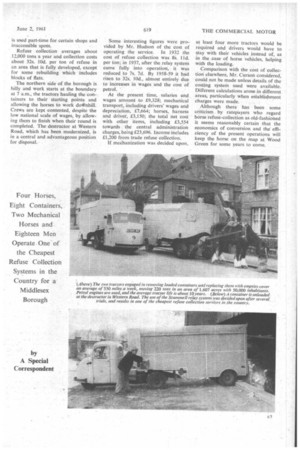Four
Page 78

Page 79

If you've noticed an error in this article please click here to report it so we can fix it.
Horse
power at Wood Green
Four Horses, Eight Containers, Two Mechanical Horses and Eighteen Men Operate Oneof the Cheapest Refuse Collection Systems in the Country for a Middlesex Borough
by A Special Correspondent
THE. municipal authority of Wood Green, on the outskirts of London, is one of the few urban districts in the British Isles still using horses for refuse collection.
An interview with Mr. J. V. Hudson, the deputy borough engineer, revealed that not only was the system in use satisfactory and more economic than a mechanical one, but that the cost of conversion and upkeep would be uneconomic at present with no advantage in efficiency.
In 1934 Wood Green employed nine horses and carts with a Shelvoke and
Drewry side-loading freighter, manned by 23 men, for refuse collection. After trials with several new systems, including the Kuka type, the Scammell relay system was adjudged most suitable to the borough's needs and ba,s been used ever since. This necessitates the use of four horses hired by the day, with drivers, under contract at £3 apiece, eight Scammell containers for door7todoor collection with interchangeable couplings and two mechanical horses, the labour force required being only 18.
The tractors do the collar Work and relay full containers to the destructor. replacing them with empties, and the net result is one of the cheapest refuse collection services in the country. The area covered is 1,607 acres with a population of 50,000. requiring the removal of 220 tons weekly.
Petrol Engines Mr. F. A. Curson. the works superintendent, estimated that the tractors in use cover an average of 550 Miles a week. Petrol engines are used because they are found to be more economic for constant starting and stopping. The average tractor life is about 10 years. The drivers are allowed time for cleaning and maintenance each week and the borough carry out alt their own repairs, including replacement of engines. Apart from occasional reeon ditioning of the front suspension and steering units, the tractors require little attention and the back axles and gears last the life of the vehicle. One spare is kept in case of breakdowns.
The containers, which have removable shafts for the horses, can hold up to 12 cu. yd. of refuse and have a movable rubber floor with a manually operated shield for compressing the refuse. They are rear-loading and obviate any need to tip. Periodic overhaul is given but hub and tyre wear is low and again average life is 10-12 years. A Bedford 21-ton lorry is used part-time for certain shops and inaccessible spots.
Refuse collection averages about 12.000 tons a year and collection costs about 32s. 10d. per ton of refuse in an area that is fully developed, except for some rebuilding which includes blocks of flats.
The northern side of the borough is hilly and work starts at the boundary at 7 a.m., the tractors hauling the containers to their starting points and allowing the horses to work do*nhill. Crews are kept contented, despite the low national scale of wages, by allowing them to finish when their round is completed. The destructor at Western Road, which has been modernized, is in a central and advantageous position for disposal. Some interesting figures were provided by Mr. Hudson of the cost of operating the service. In 1932 the cost of refuse collection was 8s. 11d. per ton; in 1937, after the relay system came fully into operation, it was reduced to 7s. 7d. By 1958-59 it had risen to 3/s. 10d., almost entirely due to increases in wages and the cost of petrol.
At the present time, salaries and wages amount to £9,328; mechanical transport, including drivers' wages and depreciation, £7,664; horses, harness and driver, £3,150; the total net cost with other items, including £3,554 towards the central administration charges, being £23,696. Income includes £1,200 from trade refuse collection.
If mechanization was decided upon, at least four more tractors would be required and drivers would have to stay with their vehicles instead of, as in the case of horse vehicles, helping with the loading.
Comparison with the cost of collection elsewhere, Mr. Curson considered, could not be made unless details of the costing system used were available. Different calculations arose in different areas, particularly when establishment charges were made.
Although there has been some criticism, by ratepayers who regard horse refuse-collection as old-fashioned it seems reasonably certain that the economics of conversion and the efficiency of the present operations will keep the horse on the map at Wood Green for some years to come.
















































































































































































